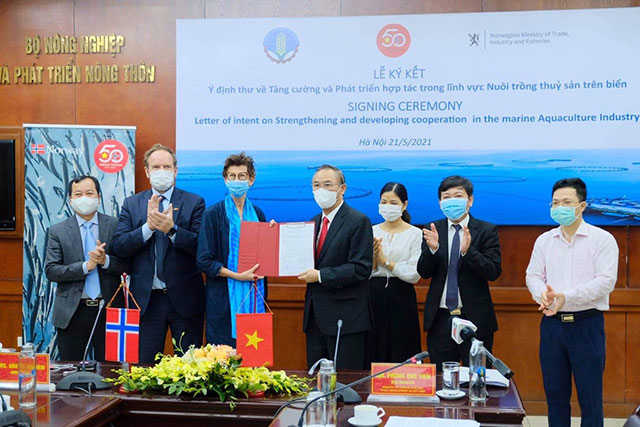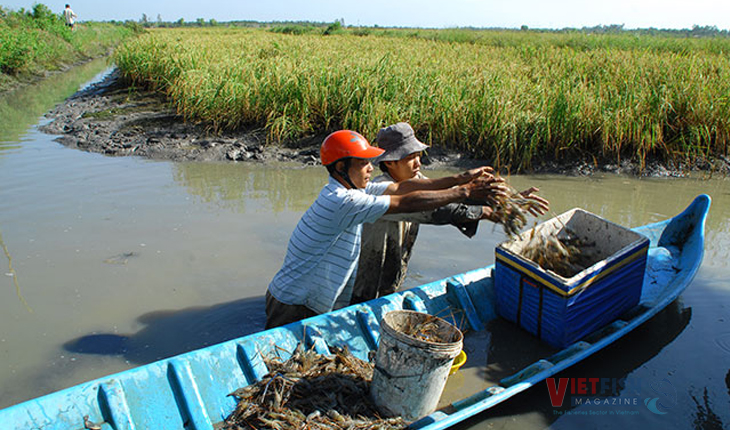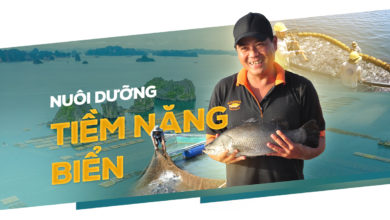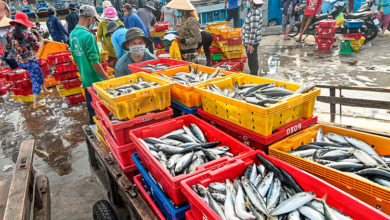Supporting access to credit for shrimp farmers
Shrimp farmers, businesses and government all claim that the fisheries sector has had many advantages and developments in recent years; however, the impact of financial policies remains limited. What should be done to support access to credit for sustainable shrimp production?
That is the major content of the workshop “Finance policies promote the aquaculture value chain development in the context Vietnam joins Free Trade Agreements (FTAs)” held by the European Union, Oxfam in Vietnam and International Collaborating Centre for Aquaculture and Fisheries Sustainability (ICAFIS) in collaborating with Academy of Finance, Vietnam Catfish Association (VINAPA) and the State banking policy and strategy institute on October 9th, in Cần Thơ.
Nguyễn Quốc Khởi, a shrimp farmer in Tân Long, Đầm Dơi, Cà Mau said that small scale shrimp farmers have limited access to credit facilities. Tạ Minh Phú, chairman of Bạc Liêu Fisheries Association cited 18 good shrimp farmers failed to get loans from the bank because after stocking bank officials found dead shrimps in their ponds.
Lâm Thái Sinh, Chairman of Minh Phú mangrove-shrimp company in Ngọc Hiển district, Cà Mau also complained that shrimp farming process meets international standards but has no access to credit because the bank only accepts the pond – which is of little value – as mortgage, while the financial investment on the input shrimps itself is not eligible to be seen as a mortgage.
Drawbacks
A survey conducted by experts from the Institute of Finance, National Economics University, Ministry of Agriculture and Rural Development, Vietnam Fisheries Association and localities shows that only 40.2% of the respondents benefited from such supportive policies, while another 41.0% did not. 18.8% of the respondents had no comment.
For businesses and the public alone, these figures are 40.4%, 22.8% and 36.8% respectively. It shows that current aids has not been so effective (to those who are really in need) as expected.
As for tax-reduction policies, the figures are 20.5%, 3.4% and 76,1%, respectively, which is quite an irony, given that a lot of tax-reduction policies have been released recently. This could stem from the lack of transparency, along with god-knows-how-many kinds of “black” extra fees and expenses that farmers have to pay.
As for credit policies which aim to encourage the development of linkages between fishery value chains, the figures are 25,6%, 9,4% and 65% respectively. The reason could be lack of clarity of the so-called comprehensive credit policies issued by the government over the past ten years (on requirements for borrowing, handling bad debts and risks, etc.) and lack of resources for implementation of such policies. The problem gets even worse and worse since credit institutions are afraid of risks.
As for policies on encouraging investment on development of fishery linkage value chains, the figures are 12%, 17.9% and 70.1% respectively. On this criteria, only 5.3% of businesses and farmers considered themselves beneficiaries. The main reason is that public investment on aquaculture is too low, which only accounts for 2.9% and 8% of public investment in agriculture and rural development in the period of 2006-2010, and 2011-2015 respectively, which is far from the expectation of 30%, which is worthy for such a high-value industry like fishery.
Solutions
Phạm Xuân Hòe, Deputy director of the SBV’s Strategy Institute explained that the financial policies for “encouraging development” did not specify what the stakeholders are supposed to do to receive the aids. As a result, the targeted beneficiaries have no idea of how to, when to apply for an aid, or where and to whom they may complain when something goes wrong. The lack of specific requirements brings difficulties to not only businesses and individuals, but also banks in implementing the policies. So, if the fisheries industry expect to revolutionize the linkage chains between production and consumption, policymakers must also carry out a revolution in policy making. “I call it synchronization in policy-making, which is a requirement for the policies to come to life” Hoe said.
Lê Anh Xuân, Director of Trúc Anh Manufacturing and Trading Company Limited in Bạc Liêu, recommends that credit policies should take on-land assets into consideration when evaluating the assets as mortgage, and at the same time remove difficulties in capital-raising, and encourage the application high technology in shrimp industry. A respective approach could be letting intensive and super-intensive shrimp farming ( which consists of one or two stages) receive different levels of loan, for example. Besides, some other solutions regarding law, financial regulations, roles and responsibilities of enterprises together with the research institutes, professional social organizations, and local authorities have been suggested, which are expected to promote sustainable and fair shrimp value chain development. Especially, the loan criteria set in correlation to the shrimp price are to be made. Consultant organizations should be developed to reach consensus in order to realize the implementation too. Aside from this, Oxfam has provided experience in piloting the value chain model for shrimp chains in Sóc Trăng, Bạc Liêu and Cà Mau provinces.
According to Lê Thanh Lựu, Director of ICAFIS until the end of the year, ICAFIS – in collaboration with the SBV’s Strategic Institution – will ask the relevant authorities to remove credit problems for the development of shrimp industry.
VFM






